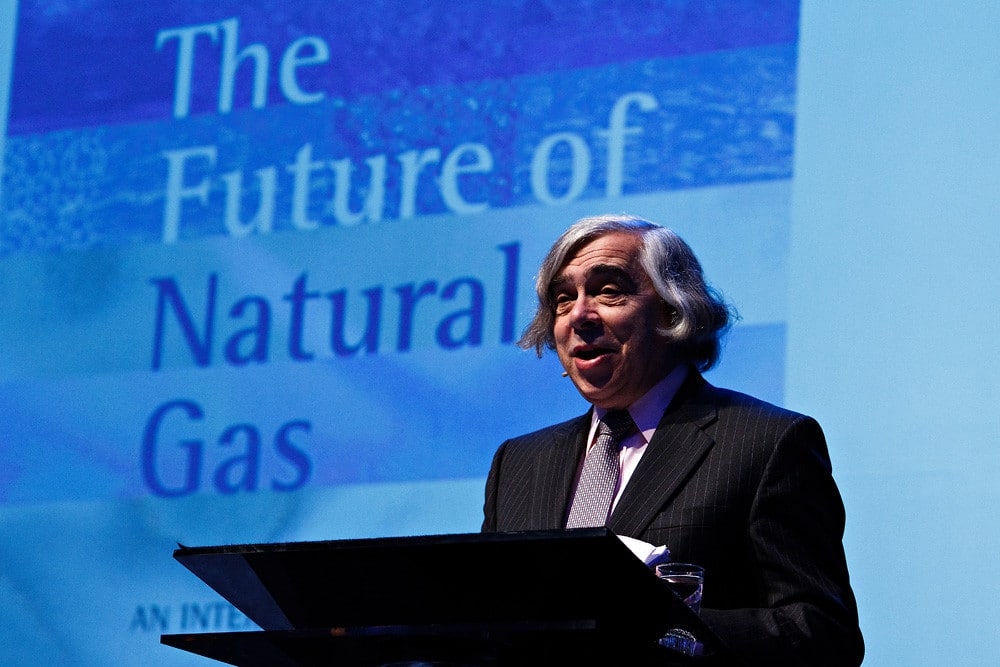An organization run by former Obama-era Energy Secretary Ernest Moniz, with the backing of the AFL-CIO, a federation of 56 labor unions, has created a policy “blueprint” to build a nationwide pipeline network capable of carrying a gigaton of captured carbon dioxide (CO2).
The “Building to Net-Zero” blueprint appears to be quietly gaining momentum within the Energy Department, where a top official has discussed ways to put elements into action using the agency’s existing powers.
The pipeline network would be twice the size of the current U.S. oil pipeline network by volume, according to the blueprint, released by a recently formed group calling itself the Labor Energy Partnership. Backers say the proposed pipeline network — including CO2 “hubs” in the Gulf Coast, the Ohio River Valley, and Wyoming — would help reduce climate-changing pollution by transporting captured carbon dioxide to either the oil industry, which would undo some of the climate benefits by using the CO2 to revive aging oilfields, or to as-yet unbuilt facilities for underground storage.
The blueprint, however, leaves open many questions about how the carbon would be captured at the source — a process that so far has proved difficult and expensive — and where it would be sent, focusing instead on suggesting policies the federal government can adopt to boost CO2 pipeline construction.
Climate advocates fear that building such a large CO2 pipeline network could backfire, causing more greenhouse gas pollution by enabling aging coal-fired power plants to remain in service longer, produce pipes that could wind up carrying fossil fuels if carbon capture efforts fall through, and represent an expensive waste of federal funds intended to encourage a meaningful energy transition.
In March, over 300 climate and environmental justice advocacy groups sent a letter to Congress, arguing that subsidizing carbon capture “could entrench the fossil economy for decades to come.”
The AFL-CIO and the Energy Futures Initiative, which jointly produced the blueprint, did not respond to questions about concerns over their proposals.
Proponents of carbon capture, usage, and sequestration (CCUS) often highlight ways that it could be used for sectors like steel and cement whose carbon pollution is generally considered “hard to abate.” Yet, the pipeline network envisioned by Moniz would be capable of carrying over 10 times as much carbon dioxide as the steel and cement industries emit in total nationwide, according to U.S. Environmental Protection Agency (EPA) data from 2019. In fact, it could transport more CO2 than the entire industrial sector emits in the U.S., leaving the rest of the pipeline network’s capacity available for carbon from fossil fuel-fired power plants or from “direct air capture” technologies that would remove ambient CO2 but don’t currently exist at a commercial level.
“Even the advocates of direct air capture technology acknowledge that they don’t anticipate that it would be at a scale to make any meaningful reduction in atmospheric CO2 levels until 2060, 2070 and beyond,” said Carroll Muffett, president of the environmental law nonprofit Center for International Environmental Law. “When we’re dealing with a world where we need to cut emissions in the next decade, direct air capture just has no meaningful place in that conversation.”
Instead, the proposed CO2 pipeline network would be used to offer a lifeline to existing fossil fuel power plants. In Appalachia, for example, 90 percent of the carbon emissions the plan seeks to capture would come from existing coal-fired power plants in the Ohio River Valley. Those plants, none of which are currently outfitted with the costly upgrades needed for capture carbon, are already facing difficult questions about their ability to compete economically with wind and solar energy.
Nonetheless, momentum behind the project appears to have been gathering behind the scenes in Washington, D.C., particularly inside the Department of Energy (DOE).
“It’s a great pleasure to have our first kind of public interaction with our good friend, Dave Turk,” Moniz said of Biden’s Deputy Secretary of Energy at the blueprint’s online launch on July 1.
“It’s incredible the volume and quality of the thought-leadership that you all are behind,” Turk, who is second in command to Energy Secretary Jennifer Granholm, told Moniz. “And I think the report that you all have put together is incredibly helpful to show that we need to do more from the DOE side, other agencies, and Congress,” he added, describing the blueprint as “actionable.”
Figuring the Federal Funding
A day before the blueprint launch event, the White House Council on Environmental Quality (CEQ) sent a report to Congress on carbon capture and its associated infrastructure.
“CO2 pipelines are critical to the future nationwide deployment of CCUS,” the CEQ wrote, leaving open the question of just how large of a CO2 pipeline network the White House supports.
The report calls carbon capture “especially important for decarbonizing the industrial sector, where high-temperature heat can be difficult and expensive to electrify” and carbon pollution difficult to avoid. The CEQ was less sure about the role carbon capture should play in electricity generation, writing that it “may also play an important role in decarbonizing the global power sector.” It also highlights the possibility that future technologies that could draw carbon dioxide from the air might use the same kinds of underground storage infrastructure.
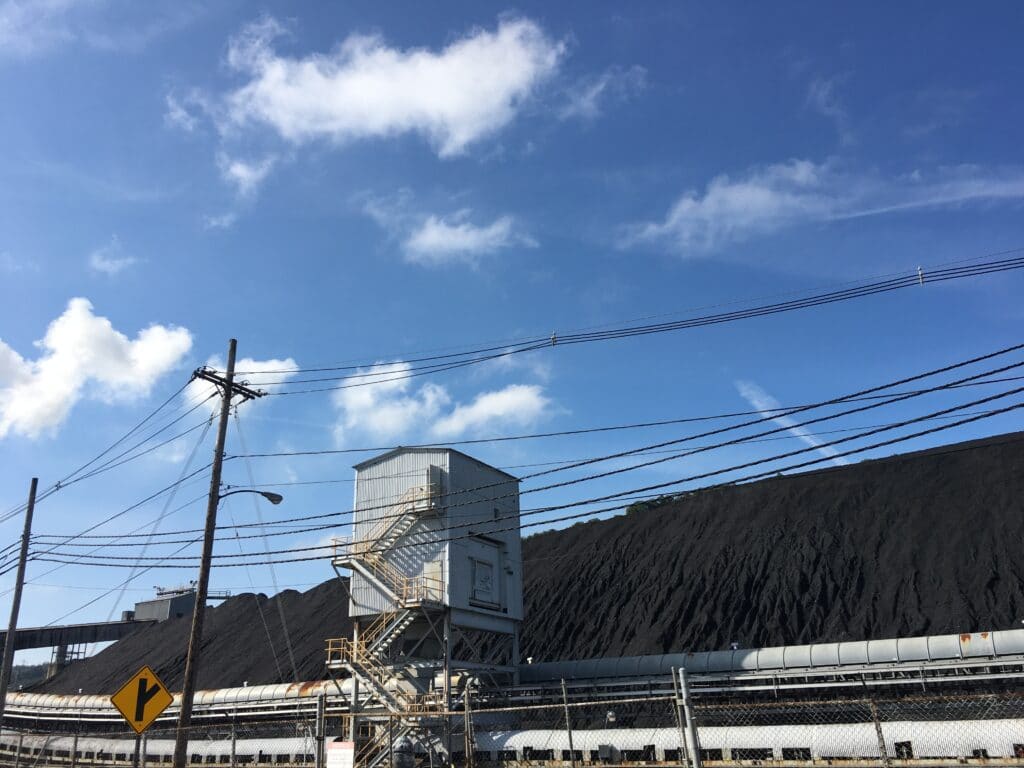
Building a national CO2 pipeline network to support CCUS would be extremely expensive. The pipelines themselves could cost between $170 and $230 billion to build, the CEQ noted, citing an estimate from Princeton’s Net-Zero America study. That’s roughly the net worth of Amazon founder Jeff Bezos — or twice the $100 billion that Biden has proposed spending to upgrade the nation’s electrical power grid.
The CEQ’s memo was greeted with enthusiasm by Moniz’s Energy Futures Initiative (EFI), a co-author of the gigaton pipeline blueprint.
“I would also like to give a big shout out to the Biden administration and its CEQ for the CCUS report they released yesterday,” said Melanie Kenderdine, a principal of EFI. “There are many similar thrusts between that report and ours.”
Discussion at the blueprint’s launch suggested that higher-ups within DOE are focused on how exactly to move forward on CO2 pipeline construction.
“So we do have authorities right now, as you certainly know, from the DOE side,” Deputy Secretary Turk explained at the blueprint’s launch. “Our Fossil Energy and Carbon Management office has authorities, has funding, we’re trying to move various programs along in that way.”
He also discussed the controversial tax credits for carbon capture, known as 45Q. “And then there’s some significant money, billions of funding, being proposed by the President through the American Jobs Plan that Congress is deliberating right now that could be hugely, hugely important on the CCUS side,” he went on. “So we’ve got some tools on the table right now at the Department of Energy but we’re really hoping and it’s encouraging to see the bipartisan support for CCUS up on the Hill, increasing the tools that we have and the size of those tools so that we can really get at the gigaton opportunities as you all lay out incredibly well in your actionable report.”
The Department of Energy also did not respond to questions about the blueprint or how often Deputy Secretary Turk has met with Ernest Moniz, the Energy Futures Initiative, or the Labor Energy Partnership this year.
An unnamed White House official told Bloomberg Law that the approach in the CEQ report remains open to modifications. “It should be interpreted as, ‘Here are the areas in which the administration plans to act. Here is how they might act in those areas. That is subject to refinement and change as the agencies carried out the more detailed process that’s necessary under their statutes,’” the unnamed official said.
Pipelines to Nowhere?
It’s not clear that carbon capture is remotely ready for prime time, particularly on a gigaton scale. “The world has been experimenting with [carbon capture] since the early 1970s,” Wood Mackenzie noted this month. “Around 68 projects started and terminated, primarily because the projects are super-expensive.”
Right now, all of the world’s existing CCUS projects combined have the capacity to remove just 37 million metric tons of carbon per year — a tiny sliver of the 1,000 million metric tons (or one gigaton) that the EFI blueprint for a U.S. CO2 pipeline network proposes.
There’s a long list of reasons that CCUS — despite decades of public subsidies and numerous high-profile pilot projects and “demonstration” plants — has floundered commercially.
First, adding carbon capture equipment to existing coal or natural gas power plants, for example, fundamentally adds costs — and today, those fuels are already under significant cost pressure as the price of renewable energy continues to fall.
The engineering side of capturing carbon can also be very difficult, particularly for some industries. When researchers, who included representatives from academia and a Chevron official, studied the costs of adding CCUS to U.S. industrial sites, they found 656 sites which they considered “suitable” for carbon capture retrofits — roughly two out of every five sites in the country.
There’s also the question of what to do with the carbon after it’s captured. Most CCUS projects right now sell carbon to the oil industry, which uses it to produce more oil from aging oil fields — not exactly a climate-friendly solution.
While backers of CCUS often focus on its role in capturing carbon not from electrical power plants but instead from industry, a one gigaton pipeline network would dwarf the size of the carbon emissions produced from “hard to abate” industries in the U.S.
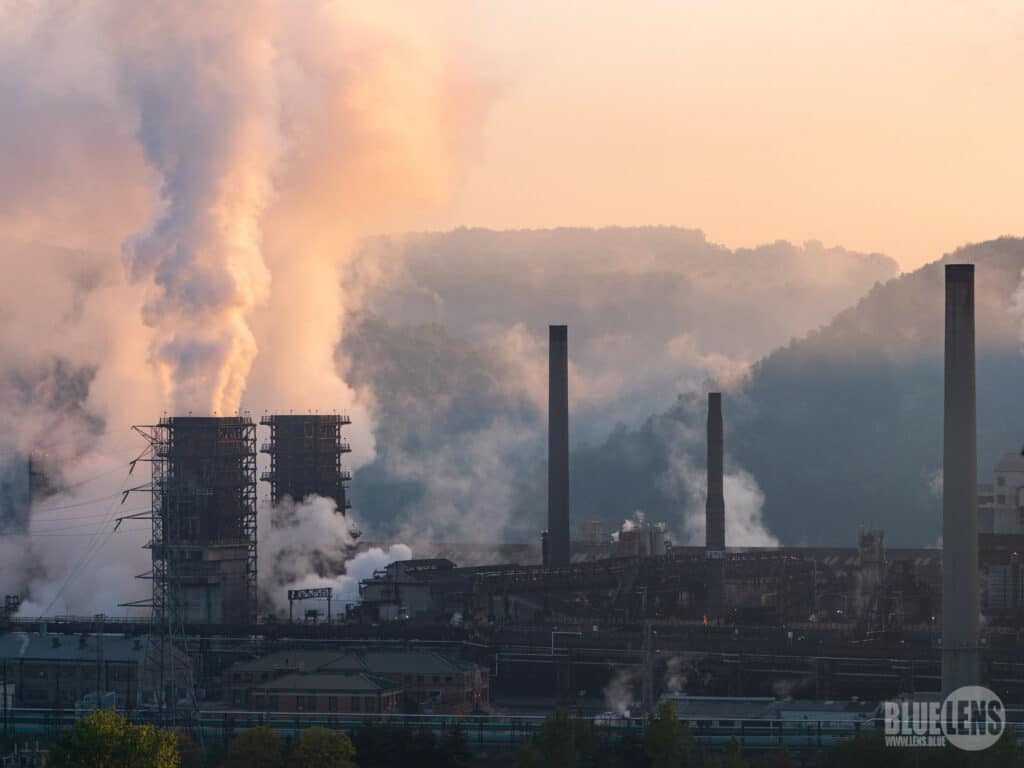
For example, the EPA’s greenhouse gas inventory lists 41.3 million metric tons (MMT) of CO2 from iron, steel, and metallurgical coke production in 2019 and a nearly equal amount, 40.9 MMT, from cement production. That’s a huge amount of greenhouse gas — but it’s only enough to fill 8.2 percent of a one gigaton pipeline network. All told, the entire U.S. industrial sector emitted 822.4 MMT of CO2 that year, EPA reported — far short of the gigaton that Moniz’s organization proposes.
“What you see in that report is a demand for a colossal expansion of CO2 infrastructure,” Muffett said, “even while acknowledging that it’s fundamentally not economic to build it even with the massive federal subsidies that are already flowing into it.”
Fossil fuels have powerful backers in Congress, including at least one senator who has suggested he might spike Biden’s climate proposals if carbon capture is not included as a way to preserve the fossil fuel industry. “I told him that I was concerned about some of the language I’d seen to move us away from fossil,” Senator Joe Manchin (D-WV) said he told President Joe Biden on July 14. “I said if you move our country away from fossil and there won’t be another country that will step to the plate to do the research and development that will fix the emissions that are coming.”
A senior ExxonMobil lobbyist recently named Manchin as “crucial” to the oil giant’s lobbying efforts in Washington, D.C., in secretly recorded remarks made to an undercover representative of Greenpeace UK and reported by the UK’s Channel 4 News, adding that the Exxon lobbyist met with Manchin’s office weekly.
Prolonging ‘Negative Attributes of Fossil Fuels’
The blueprint itself carries a long list of warnings about carbon capture’s uncertainties and flaws. “Public perceptions that contribute to negative opinions of CCUS include hesitancy about technology risks, limited track record, cost, and investment tradeoffs compared to other emissions abatement options,” the blueprint notes. “Worries about the risk of geologic CO2 leakage are also common.”
“Other concerns about CCUS include its perception as a ‘delaying tactic’ that forestalls other climate change mitigation actions, such as improved energy efficiency or transition to non-fossil fuels,” it adds. “There are also concerns that CCUS prolongs negative attributes of fossil fuels such as pollutants, environmental disruptions, and negative community impacts.”
Fossil fuel power plants with CCUS can also remain highly polluting beyond greenhouse gases — and existing plants are often located within communities of color. “Energy and industrial infrastructure is disproportionately located in or near neighborhoods of lower-income households and with larger minority group populations,” the blueprint notes. “The environmental impacts of these facilities have contributed to negative health outcomes and lowered property values in the adjacent communities.”
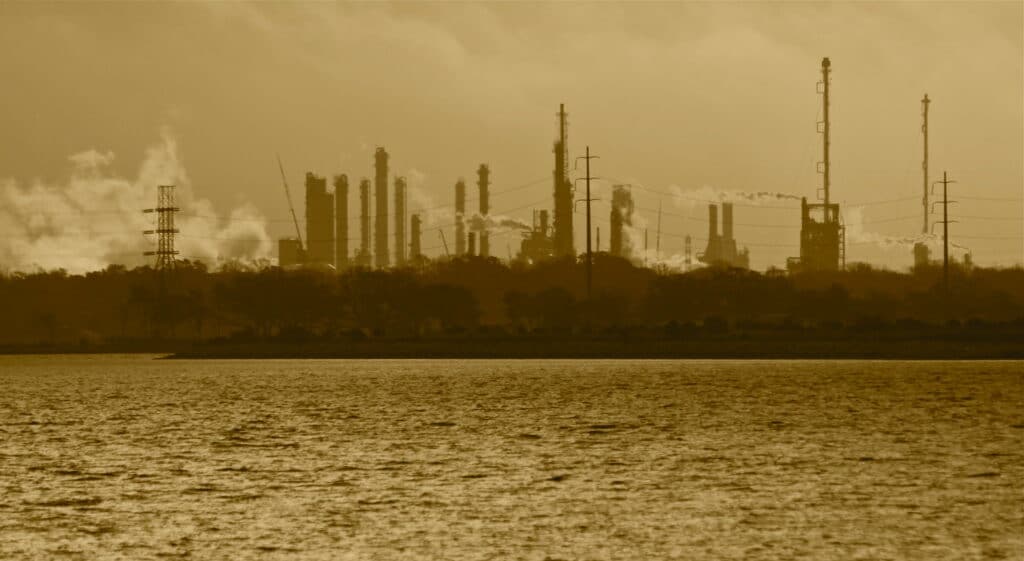
“I’m concerned about federal funding to support pipeline and hub construction, when the feasibility of CCUS remains extremely unclear,” Megan Hunter, a senior attorney with the environmental group Earthjustice, told DeSmog.
And while carbon might be captured with CCUS technology, there are many other pollutants released by fossil fuels.
“It’s also important to note that these plants, petrochemical facilities, and the other sites mentioned in this report emit more than just carbon dioxide; they emit harmful particulate matter, hazardous Volatile Organic Compounds (VOCs), and other toxic pollutants that severely threaten the health of nearby communities,” Hunter added. “The Ohio River Valley is already burdened by significant legacy pollution and experiences intense subsurface and surface activity — including underground and surface mining, pipelines, hydraulic fracturing, injection wells, and solution mining.”
“I’m also deeply concerned about the potential for federal funds to be directed towards a buildout of natural gas and petrochemical infrastructure under the guise that this infrastructure will one day be repurposed for CO2 or hydrogen,” Hunter added.
For example, utility Southern Company sank $7.5 billion into attempting to build a coal-fired power plant that would capture carbon in Kemper County, Mississippi, before abandoning those efforts amid cost overruns and increasingly evident design flaws.
The pipeline that Southern originally built to carry captured CO2 won’t be torn down, however, as the company had previously contemplated. Instead, it will be converted from a CO2 pipeline into a natural gas pipeline, Southern reported in its annual SEC filing for 2020, and used to fuel a gas-fired power plant.
Moniz sits on the board of directors of Southern Company.
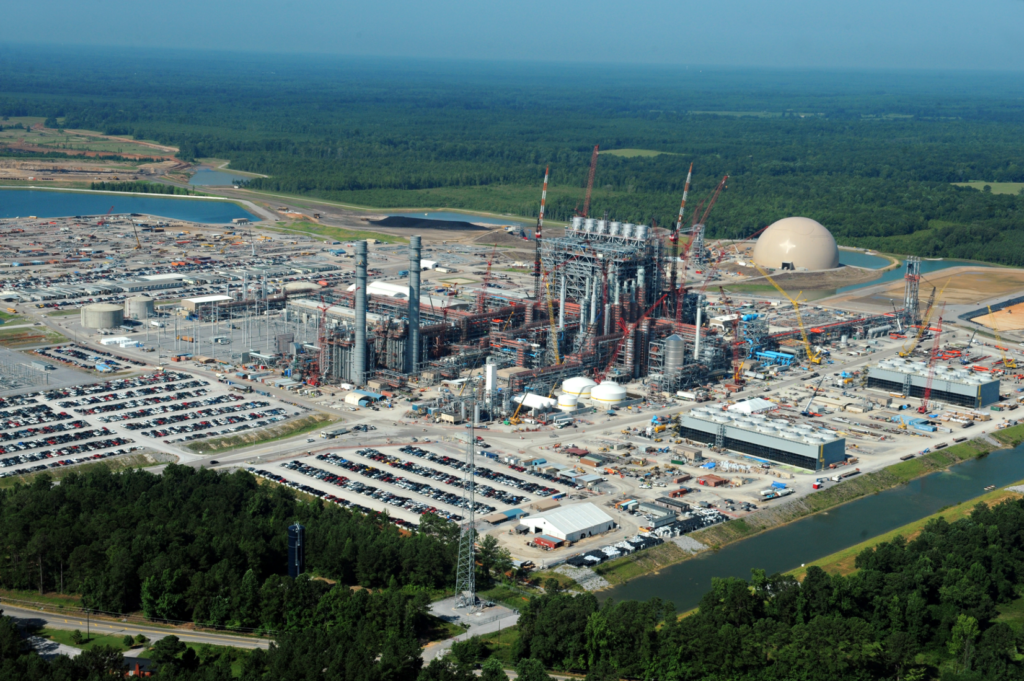
Before he joined the Obama administration, Moniz pushed natural gas as a solution to climate change, arguing in 2010 that the fossil fuel “truly is a bridge to a low-carbon future.” The following year, Cornell professors Robert Howarth, Renee Santoro, and Anthony Ingraffea published their landmark paper showing that natural gas-fired electricity may be twice as climate-altering as coal-fired electricity — or worse, depending on just how much climate-warming methane escapes from the nation’s gas infrastructure.
During his time at DOE, Moniz continued to push natural gas as a way to curb the country’s CO2 emissions, despite growing evidence that the fossil fuel’s methane leaks are very damaging to the climate. In 2020, methane levels in the atmosphere reached a record high, prompting urgent warnings from the United Nations.
Prior to the 2020 election, Moniz’s name was rumored to be among those that Joe Biden considered for Energy Secretary — but, under pressure from green groups, Biden ultimately passed him over, opting instead for Granholm, a former Michigan governor.
In November 2020, Little Sis, a Public Accountability Initiative project, highlighted the number of Moniz’s associates that played a role in Biden’s transition team, including Turk, who had served under Moniz in the Obama administration. “All this raises concerns about Moniz’s influence over the policy direction and staffing decisions within Biden’s DOE, and suggests that — even if Biden rejects Moniz himself — Moniz’s network could play a critical role in setting energy policy in the Biden administration,” Little Sis wrote.
“Moniz also launched two projects — the for-profit consulting firm EJM Associates and the non-profit think tank Energy Futures Initiative — intended to shape the policy debate around energy issues,” it added. “The Energy Futures Initiative is advised by a board chaired by former BP CEO Lord John Brown Madingley and includes former CIA director and Cheniere Energy board member John Deutch, and J. Todd Mitchell, whose family fortune comes from the fracking company Devon Energy.”
Erratic Track Record
Previous attempts to use carbon capture have largely run aground amid technical and financial issues.
“The costs of carbon capture have decreased by 35% between a first-of-a-kind power plant with carbon capture and the second facility using the same technology,” the White House CEQ wrote in the memo’s executive summary, citing a report that details the costs of Saskatchewan’s Boundary Dam project in 2014 and Texas’s Petra Nova plant in 2017 — with no mention of Southern Company’s failed attempt at carbon capture in Mississippi.
Also not mentioned: NRG’s Petra Nova project doesn’t actively capture carbon, despite its $1 billion price tag. “Petra Nova has been mothballed since May 2020 because it is uneconomic,” POWER Magazine, a trade publication, reported in late June. “Even before the plant was mothballed NRG had taken three impairment charges totaling $310 million against the project.”
“What they’re ignoring in this report are the massive risks that are entailed in dramatically expanding pipeline infrastructure.”
Carroll Muffett, President, Center for International Environmental Law
Even before the full effects of the pandemic unfolded in the U.S., the DOE itself warned that carbon capture projects aren’t financially competitive. “Additionally, as is the case for the [Petra Nova] Project, the economics of large-scale carbon capture facilities are challenging,” DOE wrote in a March 31, 2020 final scientific and technical report on Petra Nova.
That makes the Boundary Dam project in Canada the world’s only operating coal carbon capture project. The project made headlines in March when it announced it reached its 4 millionth metric ton of CO2 captured, a lifetime total equal to what one coal-fired power plant emits in one year, EPA estimates. The company was originally slated to reach this milestone by October 2018. “The carbon capture facility at Boundary Dam was designed to capture 3,200 metric tons of CO2 daily, or slightly more than 1 million metric tons annually,” the Institute for Energy Economics and Financial Analysis wrote in April. “It has barely achieved that goal on any single day and has never done so over any extended period.”
“From a purely economic perspective, [carbon capture and sequestration] does not make sense,” the Center for International Environmental Law wrote in a recent report. “The simpler, surer, and cheaper solution is to end this and similar subsidies for the fossil fuel economy and invest the savings in accelerating the transition to clean energy.”
“What they’re ignoring in this report are the massive risks that are entailed in dramatically expanding pipeline infrastructure,” Muffett told DeSmog, describing both the physical risks borne by people living near CO2 pipelines and the financial risks of investing in carbon capture rather than renewable energy. “These are communities that have dealt with the impacts of environmental injustice and environmental racism for decades and that’s laid the foundations that leads to them being targeted for the build-out of these pipelines.”
“At its heart, the conversation about CCUS has never been about addressing the climate crisis or about reducing CO2 emissions,” Muffett added. “At its heart, the thing that has always driven this conversation is how do we deal with the problem of stranded assets, what can we do to go on burning coal, natural gas, and oil into the indefinite future?”
Subscribe to our newsletter
Stay up to date with DeSmog news and alerts


